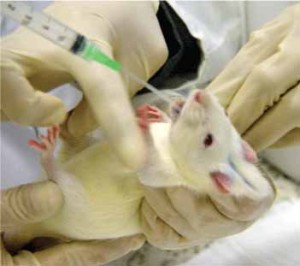
Feeding a rat by gavage
Toxicology and Industrial Health, 2013. Aug; 29(7): 616-23.
In this study, pregnant rats were given the ADI (Acceptable Daily Intake) amounts of the following food dyes by mouth, continuing to do so after the babies were born so that the pups were exposed both prenatally and through their mothers’ milk.
- Erythrosine (E127, Red 3)
- Ponceau (E124 – a red color not used in the US)
- Allura Red (E129, Red 40 )
- Sunset Yellow (E110, Yellow 6)
- Tartrazine (E102, Yellow 5)
- Amaranth (E123, Red 2)
- Brilliant Blue (E133, Blue 1)
- Azorubine (E122, D&C Red 10)
- Indigotine (E132, Blue 2)
Each day, each experimental rat was given one ml of the food dye mixture and each control rat was given one ml of water.
When the rat pups were tested, those exposed to the dyes had significantly increased activity, as well as increased exploration and anxiety, but did not seem to have spatial learning difficulty.




















